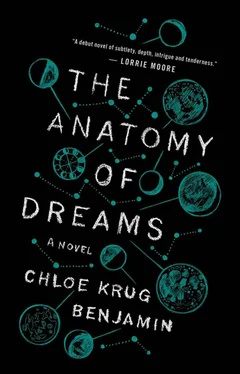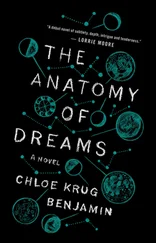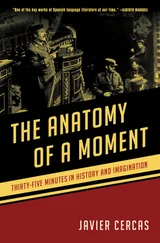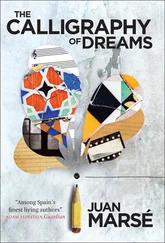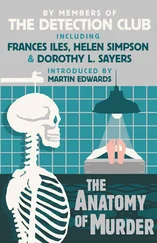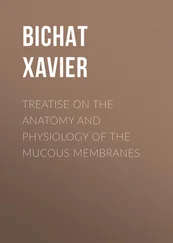At some point an elderly woman came into the bathroom. She was unremarkable — of medium build, white-haired, dressed in a dignified, old-fashioned way. The only exotic thing about her was the purse she carried: large and rectangular, like an antique doctor’s bag, with a giant metal buckle. It was made of a gleaming purple material that appeared, upon closer inspection, to be snakeskin. I observed the purse with interest but was otherwise indifferent to the woman. She walked into a stall; I heard a muffled drop as the purse was set down on the floor. I tried the faucet again, and this time, water rushed out.
I stared at the water before turning the faucet off again. The woman emerged from the bathroom stall. She was naked from the waist down. She still wore a silk blouse and cardigan, but her pressed pants and heels, even her underwear, had been removed. Between her legs was a rough gray pelt. She did not seem to notice me; she washed her hands in the water — there was no soap — and glanced briefly in the mirror. Then she walked out of the bathroom as perfunctorily as she had arrived.
The door of the stall she had used swung open with a slow, rusty whine. It was empty except for the purple snakeskin purse. Loud noises came from outside the bathroom, and I knew that others would soon come in search of the purse, that I would be implicated as its new owner. I needed to move the purse, but first I had to see what was inside it. I went into the bathroom and pressed on the buckle. There was a click like the sound of a gun’s safety being switched off. The lid of the purse opened automatically, willingly. And then I woke.
I told Gabe about the dream, late at night in the Bunk Room when we knew Keller had already gone to sleep. He listened with the knit-browed interest of a psychiatrist, and though there was no judgment in his face, he couldn’t unlock the dream any better than I could. We still slept in our own beds — still barely touched, aside from the brief brush of arms as he sidled past me in the kitchen — but we had begun to talk late into the evening, Gabe leaning over the ledge of his top bunk and I looking up from below. Sometimes we talked about our dreams. Other times, we talked about Keller.
“I just don’t believe that he’s lived here, all these years, alone,” I said one warm, sticky night in July, my legs on top of the sheets. “He never had a family of his own?”
“He had a wife,” said Gabe.
I rolled to the side of the bed and craned my neck to look at him.
“You’re kidding. He was married? When?”
“Years ago,” said Gabe. “Before he came to Mills.”
“What happened to her?”
Gabe glanced at the door. The floor was so old that if Keller was still padding around, we could generally hear him.
“She died,” he said in an undertone.
“How?”
“Beats me. That’s all I know, and I’m not even sure how I know it. Keller never mentioned her to me, that’s for sure. I think it was someone at Mills who told me — maybe Mr. Cooke.”
Gabe scrunched up his nose in the way he did when he was trying to recall some fact. Then he shook his head.
“Do you think that had something to do with it?” I asked. “With why he left USF, started teaching in a high school?”
“Who knows?” Gabe shrugged, the twin curves of his shadow shoulders rising against the opposite wall. “Anyway, there’s a picture of her in Keller’s bedroom. I stumbled in there one day, thinking it was one of the studies. It’s on his bedside table. Have a look, if you want, but make sure you don’t do it when he’s around.”
It was my first glimpse of the old Gabe. And though I knew he couldn’t see me, I was grinning in the dark.
I was eager to see the photo, if only to satisfy my curiosity about the kind of woman Keller would go for. For the next few days, I glanced in his room whenever I walked down the hall, hoping I wouldn’t have to go inside to see the photo. But the door was only ever open a crack, if at all, and soon I realized I would have to be ballsier if I really wanted to go through with it.
Keller kept to a strict schedule: he went to the grocery in Edgartown on Tuesdays and Fridays, he ate dinner no later than six thirty P.M., and he took a walk to the water each day from four thirty to five fifteen. On one Thursday afternoon in late July, Gabe was out, too — Keller had sent him to the Vineyard library to find a book on Jewish mysticism. At five P.M., seized with the fear that one of them would come home early, I opened Keller’s bedroom door.
I scanned the room, which was small and spare. Most of it was taken up by a queen bed with one pillow, white sheets precisely flattened and tucked. A painting of a battered canoe hung above the bed. Beside it was a small wooden table upon which there was a pen, a few scattered sheets of paper, and a square photograph in a gold frame.
I stole closer, making sure not to disturb the books that had been set in stacks on the floor, and picked up the frame. The photo showed a woman from the waist up. She looked to be at least in her forties, older than I expected. She had a small, fervent face, her features angular and catlike and held in place by a tight network of bones. There was something severe in her expression: the sharp little nose; the lifted chin; the pursed lips, less a smile than a contraction. But in her eyes I saw a swallowed depth and vulnerability that startled me. It’s possible I’m remembering the photo incorrectly, that I’ve ascribed this vulnerability to her in hindsight. But I remember being struck by her unusual mix of challenge and urgent appeal. Her most striking feature was a helmet of bright strawberry-red hair, which had been cropped to her chin and smoothed into a bob.
At dinner that night, I realized I hadn’t noticed the angle at which the photo had been placed before I picked it up. My body grew hot, and my heart began to pound. Gabe was telling some joke, his mouth full of pasta, Keller glancing at him with amusement. I could excuse myself from the table and go fix the photo, if I only knew how it had originally been positioned. No; it was useless. I could only pray he didn’t look at it too closely.
Years later, I found myself in the main branch of the San Francisco Public Library, and I decided to look through their archives of the Chronicle in the hopes of finding a particular article about Keller’s Snake Hollow compound. After a few hours of searching, I found it in the style section of the Sunday paper on June 18, 2000—Father’s Day of that year. “Space to Dream,” it was titled: “The Prodigal Father of Experimental Dream Psychology on His Vineyard Escape.” The text itself was not very interesting: cursory details about Keller’s approach, some of which the author had gotten wrong (“Mr. Keller is most well-known for his polarizing theory of potential simultaneities”); he was clearly more interested in the Snake Hollow property, and most of the article’s space was taken up by large, full-color photos of its interior.
June of 2000 was the summer after my freshman year of college, just before Gabe returned to work with Keller, but the house looked the way it did when we stayed there together. There was the library, vast and secretive; there was the kitchen, its white cabinets and fragile china. But something about the photo of Keller’s bedroom gave me pause. The bed was the same — even the bedding had not changed — and the canoe painting still hung above it. His night table was cluttered with papers and pens that the photographer had not moved, preferring a naturalistic effect. But the picture of Keller’s wife was gone.
There are explanations for this, of course. Perhaps Keller had moved the photo, not wanting such a personal item to be included in the article; perhaps he had simply put it on his night table sometime after the article was written. But for reasons I still can’t fully articulate, the absence of the photo confirmed my suspicion that it had been placed there for my benefit, shortly before my arrival in June of 2002. I’ve never been able to prove that Keller wanted me to see it, and I doubt I ever will. But the question has stayed with me — pesky, cobwebbed — something I come back to on nights when I can’t sleep or while on a drive that doesn’t demand much of my attention. If there are no other cars, or if the road is long and flat, dotted black and white and brown by cows and dry grass — in moments like this, I let my mind float away from my body and return to the dusty attic space in me that Keller still occupies, a place with ashy shapes and sunken goods like the ruins of an old city, a place I have never really been able to leave behind.
Читать дальше
